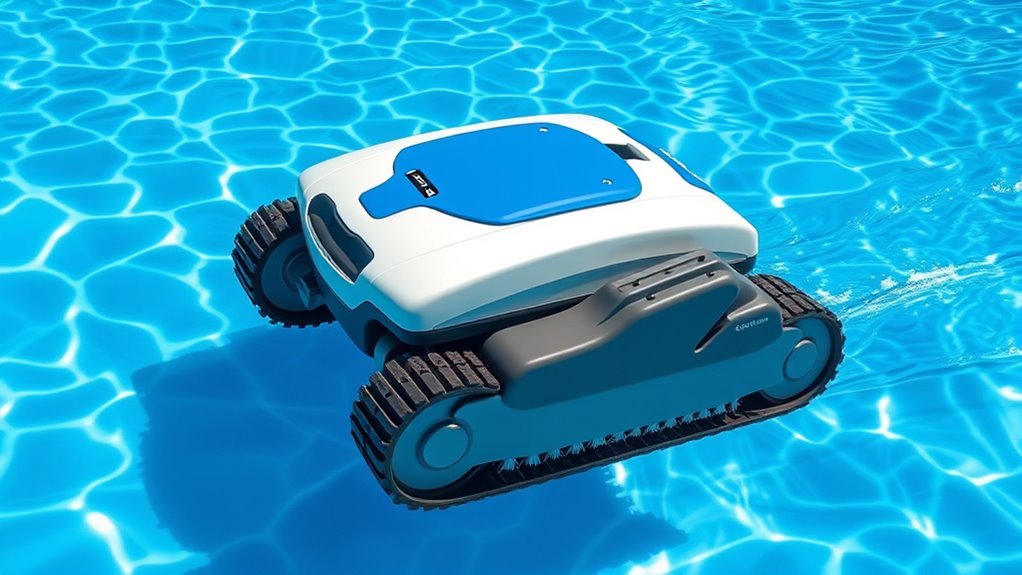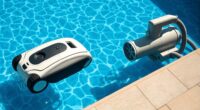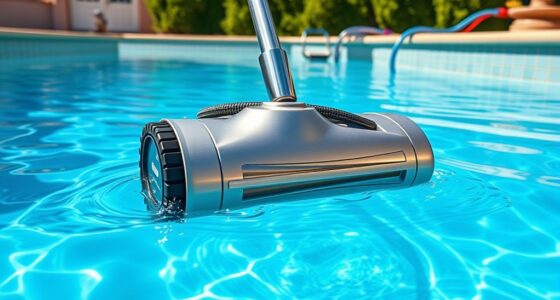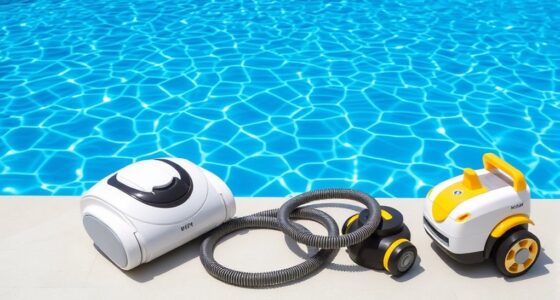Robotic pool cleaners work by using advanced sensors, motors, and navigation systems to automatically move around your pool, scrubbing surfaces and filtering debris. They use obstacle detection to avoid walls and objects, while mapping technology plans efficient routes for thorough cleaning. Their brushes loosen dirt, and powerful suction picks up debris from floors and walls. If you want to understand how all these parts come together for effortless pool maintenance, keep exploring the details behind their operation.
Key Takeaways
- Robotic pool cleaners use sensors and mapping technology to navigate and create detailed pool layouts for efficient cleaning.
- They employ brushes, scrubbers, and strong suction systems to loosen and remove dirt, algae, and debris from surfaces.
- Their motors power movement, scrubbing actions, and filtration processes to ensure thorough cleaning and water clarity.
- Obstacle detection sensors help avoid collisions and enable the robot to adjust its path in real-time.
- Preprogrammed operation cycles and customizable settings optimize cleaning coverage, efficiency, and device lifespan.
Components and Design of Robotic Pool Cleaners
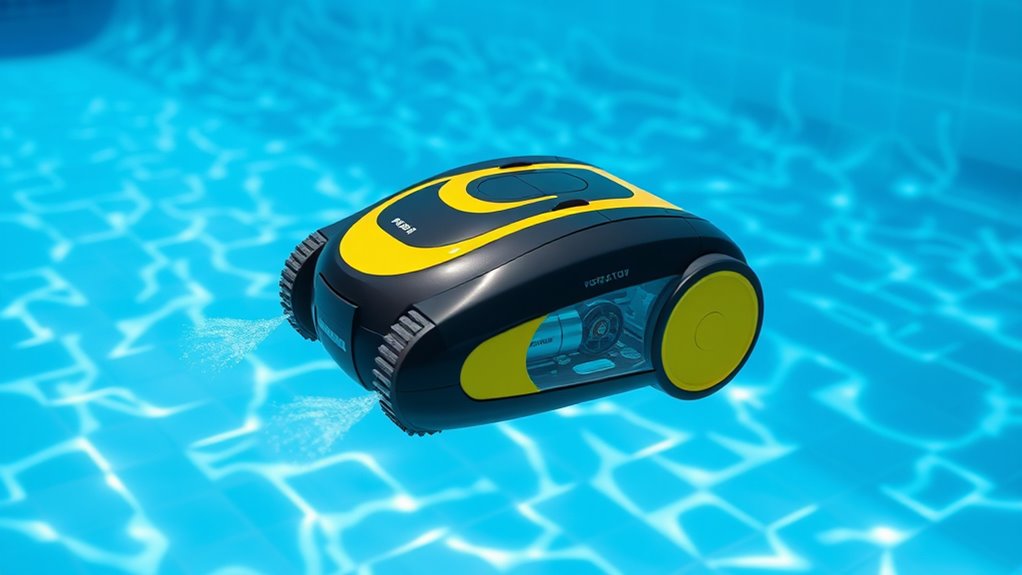
Robotic pool cleaners are designed with several key components that work together to efficiently clean your pool. The primary parts include brushes or scrubbers for pool wall scrubbing, which loosen dirt and algae from surfaces. These cleaners also feature a filtration system that captures debris, ensuring clean water. The filtration system integration allows water and debris to be separated effectively, improving overall cleaning efficiency. Inside, you’ll find motors that power movement and scrubbing actions, while sensors help detect obstacles and surfaces. The body is usually waterproof and durable, protecting internal components from water damage. Some models incorporate filters that are easy to remove and clean. Additionally, many robotic pool cleaners utilize navigation technology to systematically cover the pool area, ensuring comprehensive cleaning coverage. This technology often includes mapping features that help plan the most efficient cleaning path. Advanced models may also incorporate wireless connectivity, allowing for remote control and monitoring via smartphone apps. Altogether, these components create a compact, efficient system that keeps your pool spotless with minimal effort.
Navigation and Mapping Technologies

Navigation and mapping technologies enable robotic pool cleaners to efficiently cover every inch of your pool without missing spots or wasting time. These advanced systems use sensors, cameras, and algorithms to create a detailed map of your pool’s shape and obstacles. As a result, the cleaner can plan ideal routes, ensuring thorough coverage. This precision improves pool water filtration by preventing debris buildup in uncleaned areas. With effective navigation, you can stick to maintenance schedules more easily because the cleaner targets specific zones, reducing the need for manual intervention. Some models even remember the pool’s layout for future cleanings. Additionally, innovative designs enhance the overall efficiency and effectiveness of robotic pool cleaners. Regular maintenance plans that include preventive care can help keep these smart devices functioning optimally over time. These navigation systems often utilize mapping technology to optimize cleaning paths and avoid obstacles, further increasing efficiency. These systems also use real-time data to adapt to changes in the pool environment, ensuring consistent cleaning performance. Moreover, investing in advanced sensors can further improve the accuracy and reliability of navigation. Overall, these technologies help you keep your pool pristine while optimizing cleaning time, energy use, and maintaining proper pool water filtration.
Cleaning Mechanisms and Suction Power
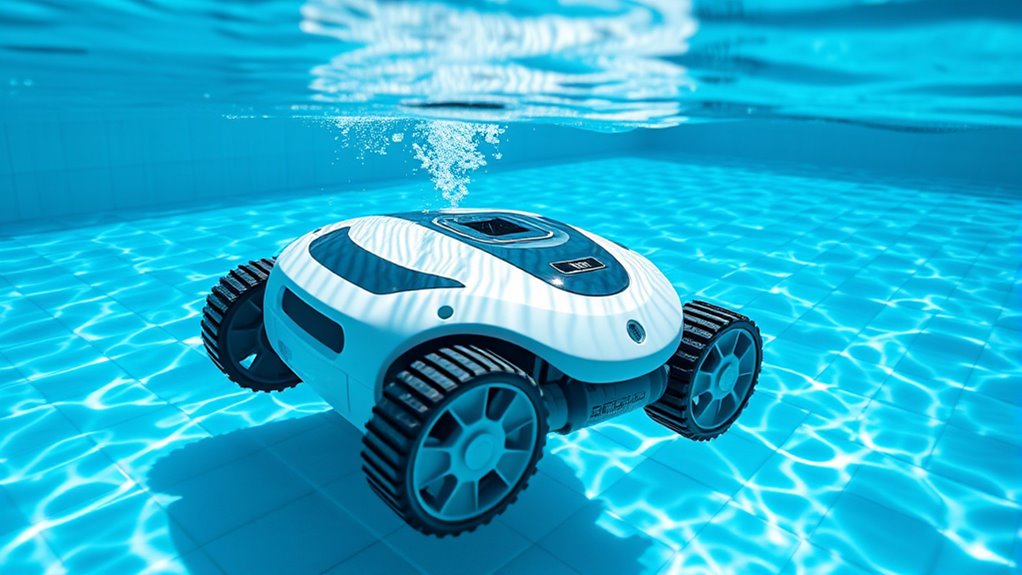
Effective cleaning mechanisms and strong suction power are vital for robotic pool cleaners to remove debris thoroughly. Your cleaner’s ability to pick up dirt depends on its filter types, such as mesh or cartridge filters, which trap particles of various sizes. Mesh filters handle larger debris, while cartridge filters capture finer dirt, ensuring a cleaner pool. Suction power determines how effectively debris is lifted from the pool floor and walls. Additionally, battery life plays an imperative role, as longer-lasting batteries allow for extended cleaning cycles without interruptions. A powerful motor combined with an efficient filtration system ensures thorough cleaning, even in challenging spots. Furthermore, understanding the effectiveness of the suction can help you choose a model that maximizes debris removal and keeps your pool pristine. Recognizing the filter maintenance needs can also extend the lifespan of your robotic cleaner and maintain its cleaning efficiency. Regularly inspecting and cleaning the filters can prevent clogs and improve overall performance, especially when dealing with a variety of debris types. Incorporating proper maintenance procedures can optimize your cleaner’s performance and longevity.
Sensors and Obstacle Detection
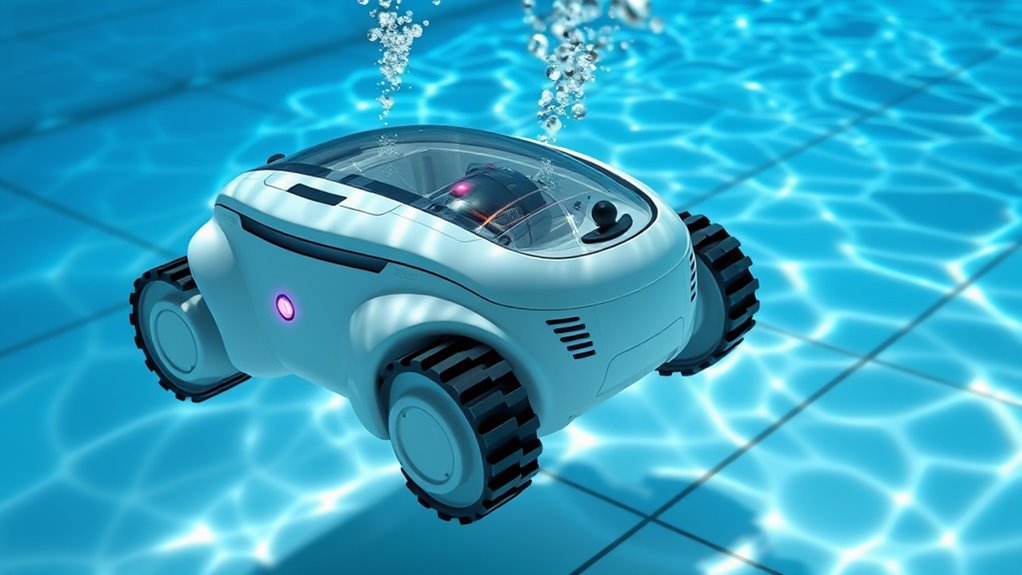
Have you ever wondered how robotic pool cleaners avoid obstacles and navigate complex pool shapes? They use sensors that detect walls, steps, and objects. Proper sensor calibration guarantees accurate readings, preventing false alarms or missed obstacles. When the sensors identify an obstacle, the cleaner adjusts its path for obstacle avoidance, preventing it from getting stuck. These sensors include infrared, ultrasonic, or contact types, each suited for different pool environments. By constantly sensing its surroundings, the cleaner can adapt its route efficiently, covering the entire pool. Automation technologies play a crucial role in enabling these intelligent navigation features. Additionally, advancements in sensor technology continually improve the accuracy and reliability of obstacle detection in various conditions. Regular maintenance and calibration of sensors ensure sustained sensor performance, further enhancing the cleaner’s effectiveness.
Programming and Operation Cycles

Once the sensors detect and identify obstacles, the robotic pool cleaner follows a specific programming sequence to guarantee thorough cleaning. This programming includes predefined operation cycles that cover the entire pool surface efficiently. You can set maintenance schedules to ensure the cleaner runs regularly, keeping your pool consistently clean. These cycles are designed to optimize energy efficiency by adjusting cleaning duration and movement patterns based on pool size and debris levels. Many models feature customizable programs, allowing you to select quick cleanings or deep cleans depending on your needs. Proper programming not only enhances cleaning performance but also extends the device’s lifespan by preventing unnecessary wear. By understanding and managing these operation cycles, you maximize your robotic cleaner’s effectiveness and save energy over time.
Frequently Asked Questions
How Long Do Robotic Pool Cleaners Typically Last?
Robotic pool cleaners typically last around 3 to 5 years, depending on usage and maintenance. Your device’s battery lifespan plays a key role in its longevity, as batteries tend to deteriorate over time. If the battery or other parts fail, replacement costs can vary, but investing in regular upkeep can extend your cleaner’s life. Proper care guarantees you get the most out of your robotic pool cleaner for years to come.
Are Robotic Pool Cleaners Suitable for All Pool Types?
Think of robotic pool cleaners as versatile sailors, steering various waters. They’re suitable for most pool types, but you should consider your pool size and water chemistry first. Larger pools might need a more powerful model, and water chemistry affects their cleaning efficiency. While they work well on in-ground and above-ground pools, always check the manufacturer’s guidelines to guarantee compatibility and peak performance for your specific pool.
Can Robotic Pool Cleaners Be Used Underwater?
Yes, you can use robotic pool cleaners underwater. They feature advanced underwater navigation systems that help them move efficiently across the pool floor and walls. Some models even come with camera integration, allowing you to monitor cleaning progress remotely. These technologies guarantee thorough cleaning without you needing to supervise constantly, making robotic pool cleaners a convenient choice for maintaining a clean pool effortlessly.
What Maintenance Is Required for Robotic Pool Cleaners?
Your robotic pool cleaner is a marvel, but it needs some TLC to stay in top shape. You should set a regular cleaning schedule to prevent dirt buildup and guarantee it runs smoothly. Don’t forget about battery maintenance—charge it properly and avoid deep discharges to prolong its life. Keep filters clean and inspect components periodically. With proper upkeep, your cleaner will keep your pool sparkling effortlessly!
Are Robotic Pool Cleaners Energy-Efficient Compared to Manual Cleaning?
Robotic pool cleaners are generally more energy-efficient than manual cleaning, thanks to their targeted operation and optimized energy consumption. You’ll notice a lower environmental impact because they use less power while effectively cleaning your pool. By choosing an energy-efficient model, you save on electricity bills and reduce your carbon footprint, making robotic cleaners a smart, eco-friendly option for maintaining a clean pool with minimal energy use.
Conclusion
Think of a robotic pool cleaner as a diligent explorer charting uncharted waters. With its sensors and mapping skills, it navigates your pool like a seasoned sailor, avoiding obstacles and methodically covering every corner. Its cleaning mechanisms act as a crew, tirelessly working behind the scenes. When you activate it, you’re setting the course—all you need to do is enjoy the pristine waters it brings, much like trusting a skilled captain to keep your vessel sailing smoothly.
